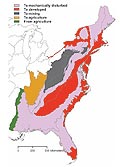Forest cover in the eastern U.S. has declined in recent decades after a period of recovery that marked much of the 20th century, according to a new study. For several decades beginning in 1920, eastern forests expanded steadily as fields previously used for agriculture were abandoned and trees regrew, researchers with the U.S. Geological Survey found. But that trend has reversed since the early 1970s, with a 4.1 percent decline in forest cover from 1973 to 2000, according to a report published in the journal BioScience. Using remote sensing imagery, statistical data, field notes, and photographs, researchers calculated that more than 9 million acres were cleared from 1973 to 2000. While abandoned fields and pastures continue to become woodlands, the study said that increases in timber production, urban expansion, mountaintop removal mining, and reservoir construction have created a net forest loss that “has important implications for sustainability, future carbon sequestration, and biodiversity.”
Eastern U.S. Forests Declining After Decades of Recovery, Study Says
More From E360
-
Solutions
From Ruins to Reuse: How Ukrainians Are Repurposing War Waste
-
ANALYSIS
Carbon Offsets Are Failing. Can a New Plan Save the Rainforests?
-
Energy
Facing a Hostile Administration, U.S. Offshore Wind Is in Retreat
-
Biodiversity
As Jaguars Recover, Will the Border Wall Block Their U.S. Return?
-
WATER
An E.U. Plan to Slash Micropollutants in Wastewater Is Under Attack
-
INTERVIEW
This Data Scientist Sees Progress in the Climate Change Fight
-
Climate
As Floods Worsen, Pakistan Is the Epicenter of Climate Change
-
Climate
Heat Stress Is a Major Driver of India’s Kidney Disease Epidemic
-
Energy
It’s a ‘Golden Age’ for U.S. LNG Industry, But Climate Risks Loom
-
Climate
How Climate Risks Are Putting Home Insurance Out of Reach
-
INTERVIEW
Inside the Plastics Industry Playbook: Delay, Deny, and Distract
-
Biodiversity
Freeing Captive Bears from Armenia’s Backyards and Basements
